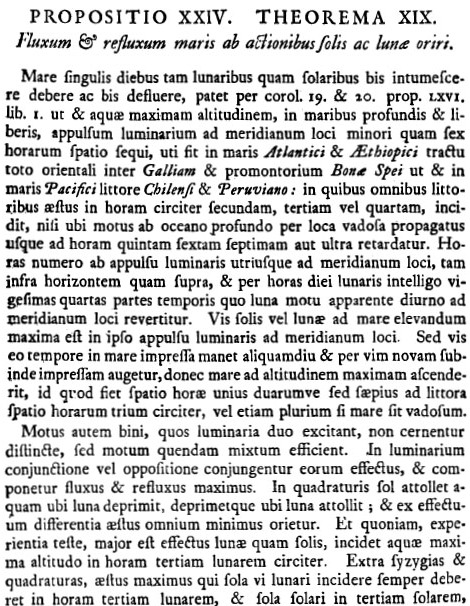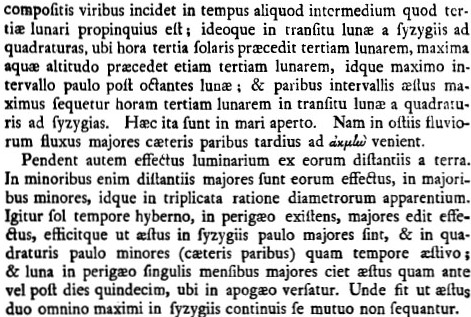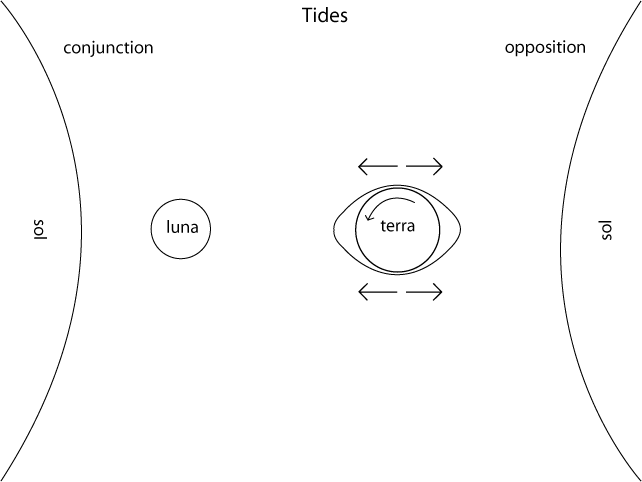Sir Isaac Newton
Philosophiae Naturalis Principia Mathematica:
Definitiones
Axiomata sive Leges Motus
Liber III: De Mundi Systemate
Regulae Philosophandi
Phaenomena
Propositio XXIV. Theorema XIX (Tides)


Background:
Because of the nature of the Mediterranean Sea, tides are almost imperceptible there. The first Greek known to describe them was Pytheas, a late fourth century BC navigator, astronomer, and mathematician, who got through the straits of Gibralter (which were usually controlled by the Carthaginians) and sailed up the North Sea. Contemporaries dismissed many of his observations. Connections of the tides with the moon were known, but an explanation for the cause of tides was still lacking in Newton’s time, and this physical explanation was one of his major contributions (though details remained to be worked out).
Characteristics of Newton’s Latin:
Notes:
line 1 *mare, maris, nt. (-i stem: abl. sing –ī; nom./acc pl. –ia, gen. pl. -ium): sea
*tam . . quam: both . . . and
lun-aribus: a lunar day is 24 hours, 50 minutes; hence the tides are 50 minutes later each day. See below (per horas diei lunaris . . .)
sol-aribus: the solar day varies, with an average of 23 hours, 56 minutes.
lines 1-2 in-tum-esc-ere: to swell up, become swollen (i.e. high tide) (Note the -sco suffix; see above)
2 patet: (from Liber I, prop. 66, corollaries 19 and 20).
4 appulsus, –ūs: approach
*lumin–arium: luminaris (as substantive) luminary [body], i.e. of the sun and moon
*meridianum: meridian (i.e. line of longitude, either directly overhead or opposite; see below)
*minori: less; modifies spatio (for the -ī ablative of comparative adjective, cf. Harvey).
5 sequi: also dependent on patet
tractus, -us: district, region, area
6 orient-ali: eastern
7 littore: = litore (< *litus)(so also, littoribus, end of line)
Chil-ensi
Peruvi-ano
8 secundam: i.e. second after the sun/moon has crossed the meridian. [see second paragraph]
8-9 incidit: Long or short “i” on -cid?
11 numero, –āre: (verb)
12 infra horizontem: i.e. away from on the opposite side of the earth.
intelligo: = intellego
12-13 vigesimas = vicesimus, -a, -um
13 motu apparente diurno: apparente because it is apparent, not actual
16-17 subinde: immediately following
18 (duarum)-ve: or (cf. –que and vel)
ad: (of location) at
(2nd paragraph) *cernō, -ere: discern, see
line 3 coniunctione: i.e. when the sun and earth are lined up together on the same side of the earth (at new moon);
lined up on the opposite sides (i.e. at full moon) = oppositio, -onis. This happens twice per month. (See diagram below)
4 fluxus . . . maximus: i.e. “spring tide.”
quadratura: the sun and moon at right angles to each other (quadrature); at this time the tide is lowest (“neap tide”).
6-7 experiente teste: ablative absolute
7 *maior: greater (more, bigger)
18 ceteris paribus: ablative absolute [still used in English today].
[Greek]: zenith, acme, peak
